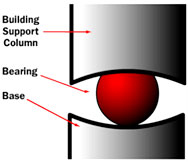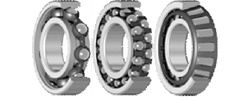Facts about Bearings
Ball Bearings have rolling elements of Balls, Roller Bearings have Rolls and Needle bearing have small cylindrical Needle Rollers.
The invention of the Ball Bearing
Leonardo Da Vinci is considered by many as the inventor of the Ball Bearing. He produced a Ball Bearing that is similar to what we use today, but Ball Bearings made of wood was used as early as the Roman times. The bike took off in the development of the Ball Bearing in the mid 1800s. Bearing Factories was founded in the late 1800s, mainly in Germany, but also in the UK and US. The worlds first Ball Bearing factory was FAG in Germany, whose founder invented a machine (grinding Balls) in 1883 that enabled mass production of Steel Balls, which was the start of the Bearing industry.
Roller Bearings was invented in the US and Spherical in Sweden
In 1898 Timken/US invented the Tapered Roller Bearing. The single-row and double row Ball Bearing was introduced in Germany in the early 1900s. Sweden would be important in the development through the mechanical engineer Sven Wingquists invention. He was one of the founder of SKF 1907= Svenska KullagerFabriken= Swedish Ball Bearing Factory. The same year he invented the multiple-line self-regulating Bearings, ie the Spherical Ball Bearing. In 1918 SKF invented the Spherical Roller Bearing, which could carry much larger axle load.
SKF later, in 1926, founded Volvo (“I roll” in Latin) to gain competitive advantages in the development of new Bearings for the automotive industry.
Needle Bearing achieved an industrial breakthrough in 1949 with the development of Needle roller cage by Schaeffler.
Both Ball Bearings and Roller bearings are one of the great inventions that laid the foundation for the rapid industrial development during the 1900s. They are now in almost all types of machines with rotary axes.
How many Bearings are there in a household?
In a modern home, there are currently between 100-200 bearings in different forms: in the washing machine, hairdryer, CD player, DVD player, computer, laptop, printer, video games, vacuum cleaner, some toys, kitchen hood, kitchen drawers, freezer, refrigerator, mixer, microwave oven, the sliding doors etc.. And then many more Bearings for those who also have a heat pump, bicycles, prams, cars, skateboards, lawn mower, pressure washer, etc..
The smallest and the biggest Ball Bearing
Bearings are available in many different forms and there are hundreds of manufacturers in the world. The smallest Ball Bearing ever produced has dimensions 0.5 x1, 5×0, 65 mm, ie 0.5 mm shaft size. The smallest in series production has dimensions of 1x3x1 mm. Small Ball Bearings/Miniature Bearing is most often used in medical technology, but also electrical, instrumentation, mechanical and aerospace engineering.
The largest Bearing has a diameter of 13,3 meters and a weight of 70 tons, according to SKF. It is said to be made for the oil field “Terra Nova” outside the Canadian coast.
Bearings and Earthquakes
One can also use Bearings to secure against earthquakes: San Francisco Airport uses advanced technology to withstand earthquakes and it involves gigantic “Bearings”. The building is supported by 267 pillars, each of which rest on a Steel Ball with a diameter of 1.5 meters. The Ball sits in a concave foundation. If an earthquake occurs, the ground can move up to 51 cm in any direction, i.e. the pillars roll on their bases. This is an effective way to distinguish the building from the movements of the ground. After the earthquake has stopped, the pillars go back to the center of their bases of gravity.


